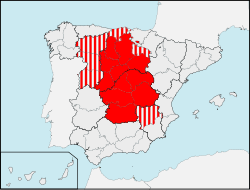This article has multiple issues. Please help improve it or discuss these issues on the talk page . (Learn how and when to remove these messages)
|
| Regions with significant populations | |
|---|---|
| Spain (Castile and Leon, Castile–La Mancha, Community of Madrid) | |
| Languages | |
| Spanish | |
| Religion | |
| Predominantly Latin Catholicism [1] | |
| Related ethnic groups | |
| Other Spaniards (Leonese, Riojans, Extremadurans, Andalusians, Valencians, Murcians) Cagots |
Castilians (Spanish : castellanos) are the inhabitants of the historical region of Castile in central Spain. However, the boundaries of the region are disputed.
Contents

Not all people in the regions of the medieval Kingdom of Castile or Crown of Castile think of themselves as Castilian. For that reason, the exact limits of what is Castilian today are disputed. The western parts of Castile and León (that is, the Region of León) and Cantabria, La Rioja, the Community of Madrid and La Mancha are often also included in the definition, but that is controversial for historical reasons and for the strong sense of unique cultural identity of those regions. The Province of Albacete and Ciudad Real are also often included. As an ethnicity, Castilians are most commonly associated with the sparsely populated inner plateau of the Iberian peninsula, which is split into two by the Sistema Central mountain range in northern or 'Old Castile' and southern or 'New Castile'.

During the Reconquista and other conquests in the Middle Ages, the Kingdom of Castile (later Crown of Castile) spread over a large part of the Iberian Peninsula, especially towards the southern Spanish regions. Starting from the late 15th century, the Spanish colonization of the Americas led to the spread of Castilians over the New World, and they brought not only their language but also elements of their culture and traditions.